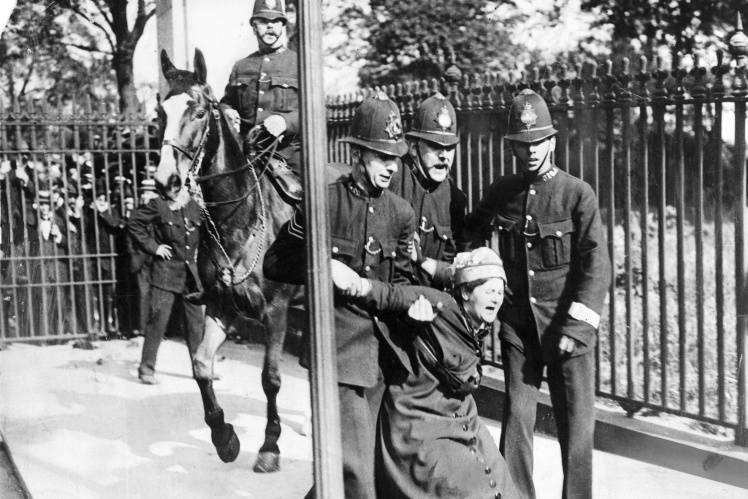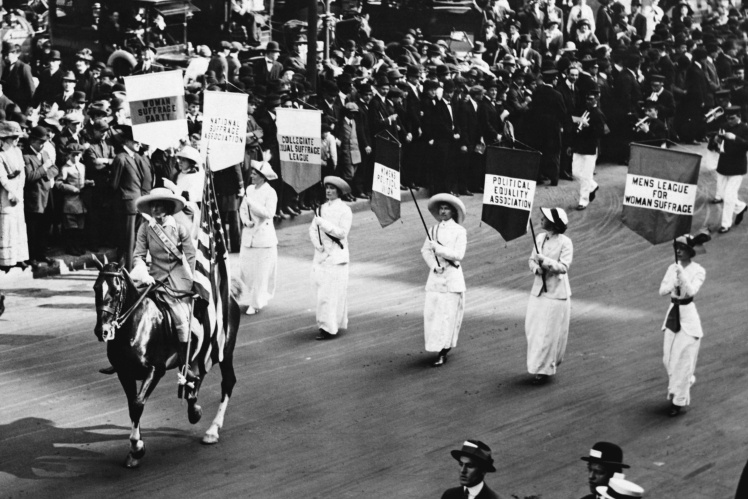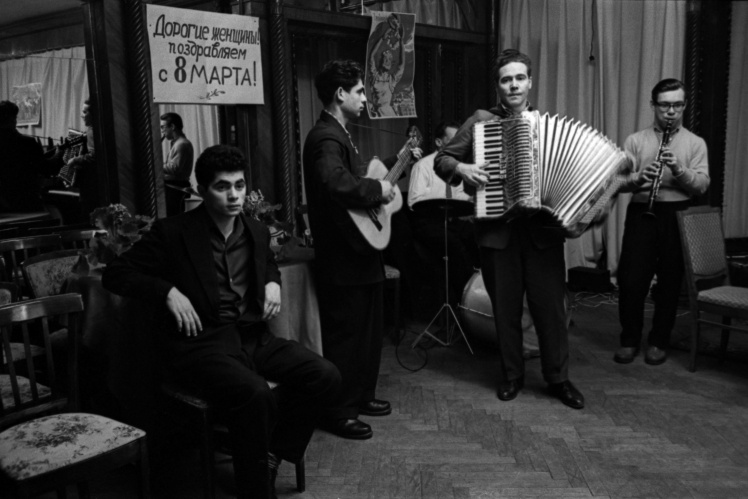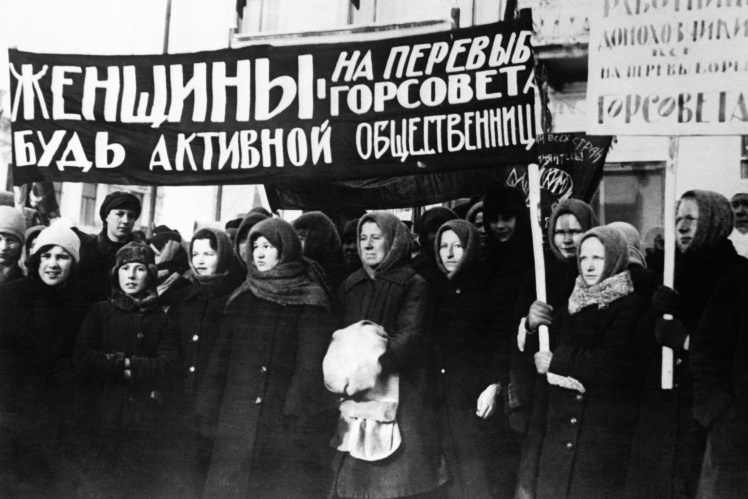At the end of the 19th century, the movement for womenʼs rights intensified in Britain and the United States. Its representatives opposed the discrimination of women in political and economic life. One of the main demands was to give women the right to vote, so the participants of this movement began to be called suffragists.
At the beginning of the 20th century, the suffragette movement was gaining momentum. Activists organized actions of civil disobedience: they chained themselves to gates, staged sit-ins on rails, and picketed administrative buildings. Later, they moved to more radical methods: they broke windows in government buildings, set fire to mailboxes, fought with the police, and in Britain even tried to storm the parliament.
British policemen detain a female suffrage rally participant, 1910. Suffragette march in New York, early 1900s.
Getty Images / «Babel'»
The idea of an annual "womenʼs day" originated in the United States. In 1908, one of the largest womenʼs demonstrations took place in New York. About 15,000 protestors took to the streets, demanding the right to vote, shorter working hours and higher wages. After that, the Socialist Party of America decided to unite womenʼs movements under its auspices and at the beginning of the next year, in 1909, announced the establishment of "National Womenʼs Day". It was planned to celebrate it with mass demonstrations and strikes led by the Socialist Party. And in order to attract as many participants as possible, the event was planned for Sunday, February 28.
March of suffragettes in New York, July 1908.
Getty Images / «Babel'»
Despite the difference in the goals of socialists and suffragists, who did not oppose the capitalist system as such, the idea succeeded. Since then, "National Womenʼs Day" in America was celebrated until 1913 on the last Sunday of February.
The idea of "womenʼs day" spread just as rapidly throughout Europe. In August 1910, the International Socialist Womenʼs Conference was held in Copenhagen, which preceded the meeting of the Second International. A delegation from the United States also came to this conference. There they met with Klara Zetkin, a well-known figure of the German Social Democratic Party at that time. Inspired by the American example, Zetkin, together with other German delegates, proposed to establish an annual International Womenʼs Day on the model of International Labor Day.
Klara Zetkin (center) with her party associates, Berlin, 1920.
Getty Images / «Babel'»
This proposal was supported by more than a hundred participants of the conference from 17 countries of the world. They adopted a resolution according to which all actions on the occasion of International Womenʼs Day should, first of all, campaign for womenʼs suffrage. However, the exact date has not been determined.
The very next year, in 1911, International Womenʼs Day was celebrated for the first time in Austria, Denmark, Germany and Switzerland. Because of German initiative, the date was chosen to be held on March 19 — in honor of the March Revolution of 1848 in Germany, which was part of a wave of democratic and national uprisings against the feudal system in most of Europe, known as the "Spring of Nations". More than a million people took part in the rallies, and not only women, but also men. They demanded that women be given the right to vote, hold public office, and receive equal working conditions.
March on the occasion of the first International Womenʼs Day, Vienna, March 19, 1911.
Getty Images / «Babel'»
In the following years, more and more countries joined the mass demonstrations on the occasion of International Womenʼs Day. However, the dates were different: in the USA it continued to be celebrated on the last Sunday of February, and in European countries — at the beginning or end of March or even in the middle of May. It was celebrated for the first time on March 8 in the USA and in a number of European countries in 1914 against the background of the threat of a large-scale war, which was gradually approaching. From the beginning of the First World War in July 1914, womenʼs actions turned into anti-war rallies.
The American delegation of the Women for Peace organization arrived at anti-war protests in The Hague on April 28, 1915.
Getty Images / «Babel'»
However, the celebration of International Womenʼs Day in 1914 on March 8 can be attributed rather to coincidence. Then this day fell on a Sunday, which made it possible to organize more massive demonstrations. This date became fixed at the request of the Russian Bolsheviks. And they, in their turn, simply appropriated it.
It all started at the end of February 1917 with mass strikes of workers in Petrograd. On February 23rd, women textile workers joined the protests under the slogans of "Bread and Peace", that is, for the end of the First World War and overcoming the food crisis. The strikers were also supported by soldiers of the local garrison, and these demonstrations turned into anti-government protests that went down in history as the February Revolution. It all ended with the abdication of the Russian Emperor Nicholas II, and power passed to the Provisional Government.
March of female strikers in Petrograd, February 23 (according to the new style, March 8) 1917. “Give food to the children of Motherland defenders” is written on one of them.
Getty Images / «Babel'»
However, the Bolsheviks frankly failed this February Revolution. The fact is that the Bolshevik party was banned in Russia as early as 1914. Some of its leaders were arrested, and the rest fled abroad. In January 1917, the Bolsheviks were by no means planning any "revolutions" in the near future. At that time, even their leader Lenin, speaking in exile to young Swiss socialists, said that "we old people will probably not live to see the decisive battles of the future proletarian revolution." The overthrow of the monarchy in Russia caught even those Bolsheviks who remained underground in Petrograd by surprise. So universal suffrage was granted to women in the remnants of the former Russian Empire, not by supporters of Lenin, but by the Provisional Government.
A banner demanding womenʼs suffrage during the February Revolution in Petrograd, 1917. “Without womenʼs participation the election rights arenʼt universal”, reads the sign.
Getty Images / «Babel'»
However, already at the end of 1917, the Bolsheviks "corrected themselves" — staged an armed coup and seized power. And in order to keep it, they appropriated various initiatives that existed even before them. The womenʼs movement was no exception. Already at the end of 1917, the Bolshevik leaders declared that the Petrograd strikers had almost become the main drivers of the February Revolution. And in 1921, International Womenʼs Day was declared a public holiday. By that time, Russia had already adopted the transition to the Western European Gregorian calendar with an adjustment of 13 days ahead. So, according to the new style, February 23 fell on March 8. Since then, the celebration of International Womenʼs Day on March 8 has spread among the countries of the socialist part of the world.
Rally on the occasion of International Womenʼs Day, Moscow, 1925. “In a Soviet country, a woman-slave became a creator of new life” is written there.
Getty Images / «Babel'»
The image of the "new Soviet woman" has become a convenient tool of Kremlin propaganda. First, it was announced that women should fight against hunger and devastation and at the same time give everything possible to the needs of the Red Army. Then they had to organize the "national economy", master "menʼs" professions and, in general, "build communism" on an equal footing with men. After the Second World War, Soviet propaganda created the image of a "housewife mother, keeper of the hearth." Despite the fact that women had to do without even elementary means of hygiene, not to mention the low level of medicine in the country.
Poster for International Womenʼs Day in the USSR, 1932. “Every female collective farm worker has to fight for the organizational improvement of collective farms!”, says one of the slogans.
Getty Images / «Babel'»
In the end, "gender equality" in the USSR reached the point where women began to be assigned a lot of responsibilities: they had to work on an equal footing with men, give birth and take care of children, and take care of the household, and, of course, be active public figures. By the way, March 8 became a day off in the Soviet Union only in 1966. But by that time, International Womenʼs Day had already transformed into a family holiday, the essence of which was to give flowers to women once a year and thank them for the cooked dinner, washed clothes, and cleaned house. At the same time, the image of the "male defender" who was welcomed on February 23 was formed.
Dance evening in Moscow dedicated to March 8, 1962. She sign on the transparent says: "Dear women, congratulations with March 8!" Rally on the occasion of International Womenʼs Day, Moscow, 1950s. "Women, rush for reelections to the city council!", reads the sign.
Getty Images / «Babel'»
In Western countries, several attempts have been made to strip the March 8 holiday of its socialist past. In the 1950s, they tried to connect it with the protests of American textile workers on March 8, 1857. However, it turned out that in the American newspapers for March 1857 there is no mention of any demonstration or womenʼs strike.
After the intensification of the feminist movement in Europe in the 1960s and 1970s, the UN tried to return the March 8 holiday to the sphere of the international struggle for womenʼs rights. Thus, 1975 was declared the International Year of Women, and the Decade of Women began in 1976. And in 1977, the UN General Assembly declared March 8 the International Day of Womenʼs Rights and World Peace. Since then, the celebration of March 8 under the auspices of the United Nations has focused on a specific theme related to gender equality every year. And in a number of countries, in particular, in Ukraine over the past decades, feminist marches are held on this day.
The womenʼs march in Kyiv on the occasion of International Womenʼs Day, which gathered thousands of participants, on March 8, 2021. “Women rights equals everyoneʼs rights”, reads one of the signs.
Sergey Morgunov / Babel
However, March 8 is still associated mostly with socialists and communists and is considered a national holiday in countries with the relevant past or present regime. And in the USA, where the first "womenʼs day" appeared, it was abandoned a long time ago in favor of Valentineʼs Day on February 14 and Motherʼs Day, which is celebrated annually on the second Sunday of May. Among Western European countries, March 8 is a public holiday and a day off only in Berlin — at the request of local socialists in 2019.
Translated from Ukrainian by Anton Semyzhenko.
Babel not only calls to fight for gender equality, but also defends these principles in practice in the editorial work thanks to your support: 🔸 in hryvnia 🔸 in cryptocurrency 🔸 via Patreon 🔸 or PayPal: [email protected].




